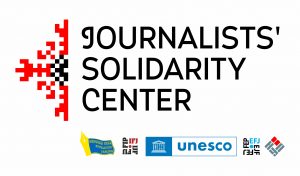…The circulation of the first issue of the local newspaper Zoria after the de-occupation of Lyman (Donetsk Region), dated October 27, 2022, was delivered to the town’s residents and a significant part of the 40 settlements of the community along with humanitarian aid.
“The previous issue is dated April 2. It means that Lyman was without the newspaper for almost seven months,” says Zoria‘s editor-in-chief Oleksandr Pasichnyk.
He, his wife Anzhelika, and a seriously ill father-in-law had to flee their hometown at the beginning of April, taking only two bags of things.
“When the active stage of the war began, we barely escaped,” says Oleksandr. “The front reached the outskirts of Lyman very quickly. Terrible shelling began. I had to sleep in the corridor at best, in the basement at worst. Sometimes we hid in garages. Lyman was destroyed by shelling. There is not a single intact house left there… Unless, maybe, somewhere in the private sector, some have survived. My father-in-law bought an apartment just before the war, but it was destroyed. My apartment was also destroyed. Garages, cottages, and sheds ‘disappeared’ along with the houses. On March 23, I had to suspend the activities of Zoria Newsroom LLC for the period of hostilities. When they left the town, “they didn’t even take winter clothes. Thanks to a fellow student” who helped us out, he didn’t refuse, invited us to live at his detached house near Kyiv… Although we hadn’t seen each other for forty years before that.”
Before the war, Lyman Zoria, in which Oleksandr Pasichnyk worked for 42 years (including eight years as the editor-in-chief), had an excellent reputation in the town. It had regular readers not only in Lyman itself but also in other cities and villages of the Donetsk Region. As for the local print media, circulation was also quite decent, with about 3,000 copies. We had a small but friendly team (five people). In 2020, Zoria celebrated its 90th anniversary. At that time, it seemed that the hardest challenges, particularly the 52-day occupation within the Donetsk People’s Republic, economic troubles, and problems with denationalization, were far behind… But we were destined to experience an even more terrible and prolonged occupation.”
Oleksandr Pasichnyk left the town but never gave up on the hope of returning to journalism. And the liberation of native Lyman from the Russian invaders made these hopes real.
“Objective information is vital for the community, where normal life has not yet been fully restored,” says the editor. “Thanks to the National Union of Journalists of Ukraine (NUJU), especially its President Sergiy Tomilenko, and foreign donors for financing the newspaper’s printing. Thanks to the Town Council and volunteers for distribution. After Zoria‘s new issue appeared in the recently-liberated town, the newsroom received much feedback from the residents. Both ordinary residents of Lyman and managers of enterprises and cultural institutions called us. Some of the institutions are currently in ruins due to Russian aggression… There were also reviews from railway workers, some currently working in different corners of Ukraine but have not abandoned ties with their hometown.”
Oleksandr remembered the feedback of the Lyman town mayor, Oleksandr Zhuravliov. “People kissed the newspaper when they received it,” said the head of the town.

Zoria is read not only in the center of the community but also in the frontline villages of the Lyman District.
“The former deputy mayor of Lyman Volodymyr Fesenko lives in the village of Torske near the front line,” says the editor. “The village was bombed to the ground, and it’s a miracle that someone still lives there. Fesenko volunteers on his street, bringing bread to those who stay there. Along with the bread, he also distributes the newspaper.”
“Thanks for the Zoria newspaper; it is read in Torsk like a combat leaflet,” Volodymyr Fesenko wrote to the Zoria newsroom. “I was there, took bread, and Zoria to people. There are 29 people on the street; everyone receives a newspaper. So, know that Zoria is on the front lines! Even soldiers read and are surprised.”

From issue to issue, one of the main topics of Zoria is the fate of Lyman railway workers and the revival of Lyman as a powerful railway hub.
The newspaper is published twice a month and distributed by local self-government bodies and volunteers. Of course, the editor would like to organize a subscription to the publication, but Ukrposhta will not deliver the newspaper to readers in the Lyman area. Negotiations are underway.
“So, for now, we are working mainly at the expense of charitable contributions. We sincerely thank the NUJU, its President Serhiy Tomilenko, the GREEN COOP organization, the Japanese future generations fund, the Academy of Ukrainian Press, and the U.S. Embassy for their support. We survived,” says Oleksandr Pasichnyk.

This story about the media was created by the NUJU as part of the Increasing Ukrainian Media Sustainability project, financed by Swiss Solidarity and implemented with the support of the Swiss non-profit organization Fondation Hirondelle and the International Institute for Regional Media and Information (IRMI, Ukraine). Fondation Hirondelle and IRMI are implementing a project of institutional support for Ukrainian media editorial teams in the east, north, and south of our country, with an emphasis on the local press. They also launched a 10-month support program for 18 media.

 THE NATIONAL UNION OF
JOURNALISTS OF UKRAINE
THE NATIONAL UNION OF
JOURNALISTS OF UKRAINE








![International Media Organizations: peace plan mustn’t envision amnesty for crimes against journalists 12 Ukrainian flag on Independence Square [Maidan Nezalezhnosti] in Kyiv, Ukraine (archive image). EPA-EFE / Oleh Petrasiuk](https://nuju.org.ua/wp-content/uploads/2025/12/maidan-flag-yezhak-2022-120x86.jpg)







Discussion about this post